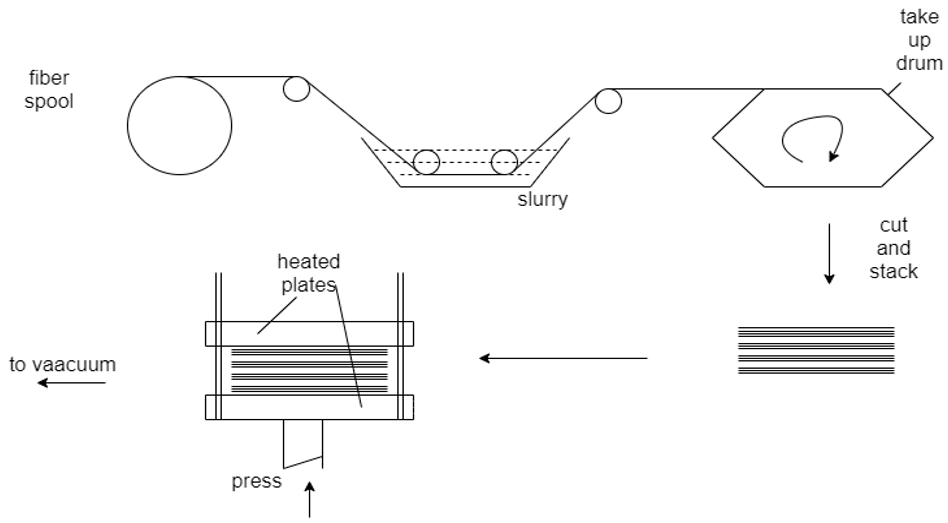This set of Composite Materials Multiple Choice Questions & Answers (MCQs) focuses on “Ceramic Matrix Composites – Set 2”.
1. What does the HIP process stand for?
a) Hot Ion Pressing process
b) Hot Isotropic Pressing process
c) Hot Isothermal Pressing process
d) Hot Isostatic Pressing process
View Answer
Explanation: Like Vacuum hot pressing(VHP), the HIP process is also used to consolidate and transform the green compact into a dense composite. The difference is, in HIP the compact must be enclosed in a gas-permeable envelope which can be removed after processing. Also, the processing temperature is lower in the HIP than VHP.
2. What is done to reduce the porosity during the hot pressing process?
a) Decrease the hot pressing temperature
b) Increase the hot pressing temperature
c) Increase pressing time
d) Decrease pressing time
View Answer
Explanation: To reduce defects in composite, specifically the porosity, the hot-pressing temperature is selected in the range of 100°C– 200°C higher than that for hot pressing the matrix alone. The probability of porosity in the composite decreases with increasing temperature.
3. What is the normal hot pressing temperature range during CMC manufacturing?
a) 200°C – 450°C
b) 600°C – 900°C
c) 1200°C – 1600°C
d) 1800°C – 2200°C
View Answer
Explanation: The normal temperature range for hot pressing is set in between 1200°C – 1600°C. It is to consolidate the green compact into a dense composite with the least occurrence of porosity defects.
4. The pressure is applied equally in all directions in the Hot isostatic pressing(HIP).
a) True
b) False
View Answer
Explanation: In the HIP process, since the pressure applied is equal in all directions, it is able to create near-net-shape structures with greater uniformity and higher density.
5. Adverse fiber–matrix reactions and fiber degradation can be reduced with a fiber coating.
a) True
b) False
View Answer
Explanation: The fiber coating acts as a shield against the chemical reactions occurring between the ceramic matrix and reinforcement phase and prevents corrosion. The fiber degradation can be also reduced by using an inert atmosphere during the hot pressing since it eliminates presence of external gases.
6. What does the CVI process stand for?
a) Chemical Vacuum Infiltration
b) Chemical Vapor Injection
c) Chemical Vapor Infiltration
d) Critical Vapor Infiltration
View Answer
Explanation: Chemical Vapour Infiltration(CVI) is a ceramic matrix composite manufacturing chemical process. The matrix is deposited on the reinforcement fibers after passing it over a preheated fiber preform from a gaseous medium. The gas is chosen such that when it comes in contact with the fibers, it reacts or decomposes. All this process is held in a controlled environment.
7. The temperature range in the Chemical Vapour Infiltration (CVI) process is 200°C – 600°C
a) True
b) False
View Answer
Explanation: The temperature range in the CVI process is set between 1000°C – 1200°C. It is lower than the hot-pressing temperature.
8. Which of these chemical processes is used for manufacturing ceramic matrix composite?
a) Polymer pyrolysis
b) Polymer hydrolysis
c) Polymer oxidation
d) Polymer condensation
View Answer
Explanation: Polymer pyrolysis consists of two steps. The first step is the impregnation of polymer onto the preform using standard polymer impregnation techniques. It is followed by the pyrolysis of polymer impregnated preform at high temperature to form the ceramic matrix composite.
9. What is the ideal temperature range for the polymer pyrolysis process?
a) 1800°C – 2400°C
b) 1200°C – 1700°C
c) 700°C – 1000°C
d) 200°C – 600°C
View Answer
Explanation: The temperature range for the pyrolysis is between 700°C – 1000°C, which is less than the hot pressing process temperature. Since the temperature is lower, a wide range of fibers which cannot be processed using hot pressing can be done using polymer pyrolysis.
10. Identify the process from the diagram illustrated below:

a) Chemical Vapour Infiltration
b) Polymer pyrolysis
c) Powder consolidation process
d) Liquid metal Infiltration
View Answer
Explanation: Powder consolidation is one of the general techniques used for the manufacture of ceramic matrix composite. There are two major stages in this process. The first step is the preparation of a green compact. This is followed by the consolidation of the compact using hot pressing techniques like vacuum hot pressing or hot isostatic pressing. It is done by placing the stack in between the heated plates of the press as shown in the diagram. The stack is then consolidated raising the temperature and applying pressure.
Sanfoundry Global Education & Learning Series – Composite Materials.
To practice all areas of Composite Materials, here is complete set of 1000+ Multiple Choice Questions and Answers.
If you find a mistake in question / option / answer, kindly take a screenshot and email to [email protected]
